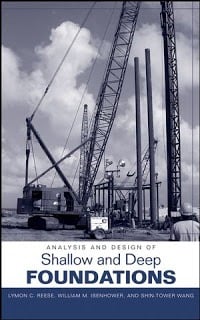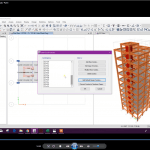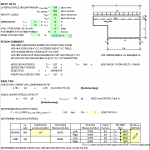
Analysis and Design of Shallow and Deep Foundations
4 December 2017Analysis and Design of Shallow and Deep Foundations
Advances in foundation engineering have been rapid in recent years. Of note
are the maturity of the concepts of soil–structure interaction, the development
of computer codes to deal with advanced topics, the advent of new methods
for the support of structures, and the proliferation of technical publications
and conferences that present a variety of useful information on the design and
performance of foundations.
are the maturity of the concepts of soil–structure interaction, the development
of computer codes to deal with advanced topics, the advent of new methods
for the support of structures, and the proliferation of technical publications
and conferences that present a variety of useful information on the design and
performance of foundations.
This book takes advantage of these advances by presenting methods of analysis while being careful to emphasize standard methods such as site visits and the role of engineering geology.
The goals of the engineer in the design of foundations are to achieve a
system that will perform according to stipulated criteria, can be constructed
by established methods, is capable of being inspected, and can be built at a
reasonable cost.
system that will perform according to stipulated criteria, can be constructed
by established methods, is capable of being inspected, and can be built at a
reasonable cost.
Builders have realized the need for stable foundations since structures began
rising above the ground. Builders in the time of the Greeks and the Romans
certainly understood the need for an adequate foundation because many of
their structures have remained unyielding for centuries.
rising above the ground. Builders in the time of the Greeks and the Romans
certainly understood the need for an adequate foundation because many of
their structures have remained unyielding for centuries.
Portions of Roman aqueducts that carried water by gravity over large distances remain today. The Romans used stone blocks to create arched structures many meters in height
that continue to stand without obvious settlement.
that continue to stand without obvious settlement.
The beautiful Pantheon, with a dome that rises 142 ft above the floor, remains steady as a tribute to builders in the time of Agrippa and Hadrian. The Colosseum in Rome, the
massive buildings at Baalbek, and the Parthenon in Athens are ancient structures
that would be unchanged today except for vandalism or possibly
earthquakes.
massive buildings at Baalbek, and the Parthenon in Athens are ancient structures
that would be unchanged today except for vandalism or possibly
earthquakes.
[su_button url=”https://drive.google.com/open?id=1TFgO52gX4FAPtOD1QSQ1wKoLi15mP6Zc” size=”7″ center=”yes”] Download Link[/su_button]








